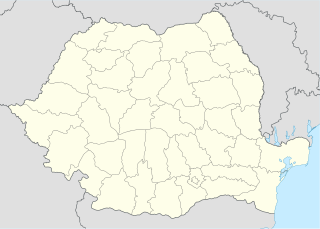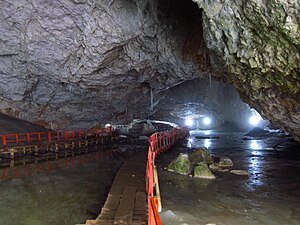Scărișoara cave
| Scărișoara cave
|
||
|---|---|---|
|
The church hall |
||
| Location: | Câmpeni , Alba County , Romania | |
| Height : | 1082 m | |
|
Geographic location: |
46 ° 29 '23 " N , 22 ° 48' 35" E | |
|
|
||
| Geology: | limestone | |
| Type: | Ice cave | |
| Discovery: | 1863 | |
| Overall length: | 750 m | |
| Length of the show cave area: |
250 m | |
The Scărişoara Cave ( Romanian Peştera Scărişoara ) is an ice cave at 1082 meters above sea level in the Romanian Apuseni Mountains , about 40 kilometers from the city of Câmpeni . From Gârda de Sus you can reach the caves on a 10 km long, narrow asphalt road. It is part of the Apuseni Nature Park and comprises the most compact underground ice block in Europe with a volume of 75,000 cubic meters and a thickness of up to 26 meters. Pollen analyzes date the ice to an age of around 3500 years.
Emergence
According to scientific findings from the Emil Racoviță Speleological Institute in Cluj, the water of the nearby Ocoale valley gnawed the limestone on the surface of the mountains a million years ago, creating the karst landscape . The water penetrated underground, where over time it washed cavities in the rocks. This is how today's caves were created. Underground glaciers formed during the Ice Age . While the ice in the other caves disappeared again, the glacier in Scărișoara was able to exist underground. Since the cave is only connected to the surface by a single opening, the ice remains in spite of the extremely high temperatures even in the summer months. While in winter the cold air sinks down through the gorge and thus gets into the cave, in summer the warm, lighter air stays above. In addition, the ice block acts like a cooling unit. The ice landscape is constantly changing. In spring, meltwater enters the gorge from the surface and turns into ice. Only a small part of it melts in the cave because of the summer temperature. The glacier increases by a new layer of ice from year to year. The ice disappears again at a depth of over 90 meters. Here the temperature of the rock increases. Pollen analyzes have confirmed that the oldest ice on today's glacier is 3500 years old.
description
Scărișoara Cave is the largest tourist attraction in the Apuseni Mountains in northwestern Romania. The entrance shaft with steeply sloping rock walls is 50 meters wide and 48 meters deep. A steel ladder attached to the stone leads to 450 steps to the cave entrance.
The underground ice deposits have a circumference of 75,000 cubic meters and a thickness of up to 26 meters. Their maximum age was dated to 3500 years with the help of pollen analysis. The Scărișoara Cave is only a small section of a much larger underground system that is spread over several floors in this region. The Austrian speleologist Adolf Schmidl first mentioned the Scărișoara Cave in 1863 and created the first cave plan.
The cave is divided into several sectors that have different names. The "Great Hall" (Romanian: Sala Mare ) is 109 meters long and 78 meters wide. It makes up the actual cave area. Solid ice covers the ground, stalagmites and stalactites of meter-thick ice surround the glacier block and form an underground labyrinth. The "church" (Romanian: Biserica ) is the room with the most beautiful ice formations. Most of the stalagmites can be seen in late winter and early spring. The other rooms are reserved for scientists: “Rezervatia Mica”, “Rezervatia Mare” and “Galeria Coman”.
A small, eyeless endemic beetle is native to the Scărișoara cave. The French entomologist René Jeannel named him Pholeuon proserpinae glaciale and found that he could not survive outside the cave. In the cave itself, however, he proves to be a survivor. It is based on the smell, its source of food is ancient organic residues in the melt water of the ice. In addition, fossilized mountain goat bones were found at a depth of 100 meters. Speleologists also dated these to over 3000 years.
The cave has been declared a natural monument and a speleological reserve.
Legends
There are several legends about the Scărișoara Cave. According to a legend, the dragon Solomat is said to have once lived in the cave. Every year he kidnapped a girl, either on New Year's Day or the night before the "Girls' Market in Gâina". He hid her in his ice palace and she was never seen again.
According to another legend, there were two pools filled with water behind a rock formation called La Brazi . If one kneeled down in front of the basin with bare head and drank the water while making a wish, then this wish would come true, provided that one did not tell anyone about the wish for a year.
Web links
- Video material , Scarisoara Cave, Romania
Individual evidence
- ↑ a b c The Scărişoara Cave , accessed on January 30, 2014
- ↑ a b c The bizarre world of the cave glacier , accessed on January 30, 2014
- ↑ a b c Pestera Scarisoara, Bihor, Romania , accessed January 30, 2014



